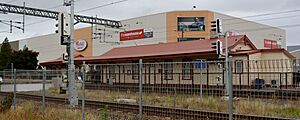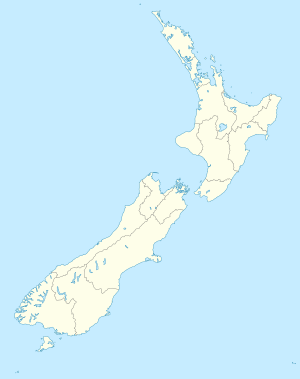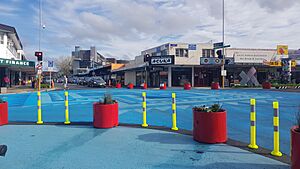Henderson, New Zealand facts for kids
Quick facts for kids
Henderson
|
|
|---|---|
|
Suburb
|
|

The old Henderson railway station with WestCity Waitakere in the background
|
|
| Country | New Zealand |
| Local authority | Auckland |
| Electoral ward | Waitākere ward |
| Local board | Henderson-Massey |
| Established | 1844 |
| Area | |
| • Land | 6.65 ha (16.43 acre) |
| Population
(June 2023)
|
|
| • Total | Expression error: Unrecognized punctuation character "[". |
| Train station(s) | Henderson Railway Station Sturges Road Railway Station |
| Hospitals(s) | Waitakere Hospital |
|
|
||
Henderson (also called Ōpanuku in Māori) is a busy suburb in Auckland, New Zealand. It's about 13 kilometers (8 miles) west of Auckland city center. It's also 2 kilometers (1.2 miles) west of the Whau River, which is an arm of the Waitematā Harbour.
Henderson first grew around a timber mill owned by Thomas Henderson. It was known as Henderson's Mill back then. As it got bigger, people just called it Henderson. Later, it became its own independent town. In 1989, it became the main center of Waitakere City. Then, Waitakere City joined with other areas to form the new Auckland Council.
Contents
Exploring Henderson's Location and Nature
Henderson is located between the Waitākere Ranges to the west and the Te Atatū Peninsula to the east. The area is part of the Te Wai-o-Pareira / Henderson Creek catchment. This creek is an arm of the Waitematā Harbour. Several streams, like the Opanuku, Oratia, Swanson, Momutu, and Paremuka streams, all meet at Te Wai-o-Pareira / Henderson Creek. This happens north of Henderson.
Millions of years ago, the land in this area was shaped by powerful natural forces. The Waitākere Ranges and central Auckland were pushed upwards. Meanwhile, the Manukau and inner Waitematā harbors sank down. The ground in Henderson is made of sandstone, which used to be at the bottom of a deep basin. Near Te Wai-o-Pareira / Henderson Creek and the Waitematā Harbour, the land has clay and peat. These come from eroding soil and how the land interacts with the harbor.
Before people arrived, Henderson was covered in thick forests. These forests had many native trees like pūriri, karaka, kohekohe, and māhoe. In the wet areas near the creek and harbor, you would find kahikatea, pukatea, and rātā trees. Cabbage trees (tī kōuka) also grew well in these wetter spots.
A Look at Henderson's Past
Henderson is in the traditional area of Te Kawerau ā Maki, a Māori iwi (tribe). The name Ōpanuku comes from the Opanuku Stream. Its traditional name was Te Wai-ō-Panuku, meaning "The Stream of Panuku." Panuku was an important ancestor of Te Kawerau ā Maki. The lower Opanuku Stream area was called Waitaro, because taro plants were grown there.
The place where the Opanuku and Oratia Streams meet is the start of Te Wai-o-Pareira, also known as Henderson Creek. This spot was important because it was where waka (Māori canoes) could travel up the creek. Te Kawerau ā Maki saw this as a key location. There was a small fortified village called Te Kōpua here. Another settlement nearby, Kōpūpāka, was used temporarily by Ngāti Whātua during a peaceful time in the Musket Wars in the 1820s. After these wars, Te Kawerau ā Maki returned in the 1830s. Most chose to live near a defensive village at Te Henga / Bethells Beach.
Henderson is named after Thomas Henderson. He was a Scottish settler who bought land from Ngati Whatua in 1844. Around 1847, he built a timber mill on the banks of Te Wai-o-Pareira / Henderson Creek. This mill processed logs from kauri trees cut from the Henderson Valley and the Waitākere Ranges. The community that grew around the mill was called Henderson's Mill. The first European settlers were mill workers. Later, gum diggers, farm workers, and brick makers joined them.
In 1855, George Pirrit and his son William bought land near the Oratia Stream. They built a dam to power a water turbine. This machine made iron plates for boots. The next year, a hotel opened on the town's main street.
The mill closed in the late 1860s. In 1875, a big flood hit the area, damaging farms and bridges. Henderson became more successful in the 1880s when the North Auckland Railway opened. When the Henderson railway station opened, the name on the sign was Henderson Mill, without the 's. Over time, goods sent by train started using this name. Eventually, the whole settlement became known as Henderson. In the late 1800s and early 1900s, Henderson had many brick and pottery factories near Te Wai-o-Pareira / Henderson Creek. In 1896, a community hall was built for concerts. It burned down in 1924 but was rebuilt with bricks.
In 1907, Assid Abraham Corban, a Lebanese New Zealander, started a vineyard in Henderson. When alcohol sales were banned in Henderson because of the temperance movement, Corban opened a shop just outside the ban area to sell his wines.
By the 1920s, areas like Lincoln Road, Swanson Road, and Sturgess Road had many orchards. These were mostly run by families from Dalmatia (now part of Croatia) who had moved to New Zealand. Some of these families included Bilich (later White), Babich, Boric, Yelavich, and Fredatovich. During this time, Te Wai-o-Pareira / Henderson Creek at Tui Glen Reserve became a popular place for boating and fun. The first modern brick shops were built in 1932. In the early 1930s, a kauri gum refinery was built on Station Road. However, it closed in 1936 due to a drop in the market.
Fun Things to Do in Henderson
Henderson has a large shopping center called WestCity Waitakere. There are also many other shops and big stores in the area. The West Wave Pool and Leisure Centre is a great place for swimming and sports. It's owned by the Auckland Council. This center was built to host swimming events for the Aquatics at the 1990 Commonwealth Games.
You can also visit the Corban's Wine Estate and Corban Estate Arts Centre in Henderson. The annual InterACT Disability Arts Festival is held at the art gallery there. At the northern end of Henderson, near the Lincoln Road motorway exit, you can see the Toroa. This is a historic ferry that is being restored, and it's a well-known local sight.
The Trusts Stadium is a big sports and event venue. It brings in hundreds of thousands of visitors each year. It hosts concerts, sporting events, and community gatherings. The stadium was finished in August 2004 and opened by the Prime Minister, Helen Clark, the next month. It cost $28 million to build.
The Falls Hotel is a historic hotel located in Falls Park. It now has a café and restaurant where you can enjoy a meal.
People and Community
Henderson covers an area of about 6.65 square kilometers (2.57 square miles). As of 2023, it has an estimated population of about 16,503 people. This means there are about 2,482 people living in each square kilometer.
The population has grown over the years. In 2006, there were about 7,029 people. By 2018, it grew to 15,663, and in 2023, it reached 16,503.
In the 2023 census, there were 8,016 males, 8,430 females, and 60 people of other genders. About 19.4% of the people were under 15 years old. About 15.7% were 65 or older.
People in Henderson come from many different backgrounds.
- About 42.5% are European (Pākehā).
- About 17.7% are Māori.
- About 23.0% are Pasifika.
- About 31.4% are Asian.
- About 2.9% are from the Middle East, Latin America, and Africa (MELAA).
- About 2.0% are from other groups.
English is spoken by most people (90.9%). Other languages spoken include Māori (4.1%) and Samoan (7.7%). Many other languages are also spoken (27.2%).
When it comes to beliefs, about 40.4% of people are Christian. Other religions include Hindu (5.7%), Islam (3.3%), and Buddhist (1.7%). About 39.2% of people said they had no religion.
Many people in Henderson have good education. About 22.1% of people aged 15 or older have a university degree or higher. About 44.3% have a certificate or diploma after high school.
Schools in Henderson
The first school in Henderson opened in 1873. It was held in the library of Henderson's Mill.
Henderson has several schools for different age groups:
- Henderson High School (years 9-13) opened in 1953.
- Waitākere College (years 9–13) opened in 1975.
- Liston College is a Catholic school for boys (years 7–13).
- St Dominic's College is a Catholic school for girls (years 7–13).
For younger students:
- Henderson Intermediate (years 7–8) opened in 1964.
- Henderson School (years 1-6) was founded in 1873.
- Henderson South School (years 1-6) opened in 1967.
- Henderson North School (years 1–6) celebrated its 50th birthday in 2007.
- Holy Cross School is a Catholic primary school (years 1-8). It celebrated its 75th birthday in 2007.
Getting Around Henderson
The Western Line train track runs through Henderson. The Henderson Railway Station is right next to the main shopping center and a bus stop. This makes it easy to travel by public transport. The suburb also has the Sturges Road Railway Station.
If you're driving, you can get onto the motorway easily from Lincoln Road. Henderson is also part of the Project Twin Streams. This project has created many walkways and cycleways that go through the suburb, perfect for walking or biking.



